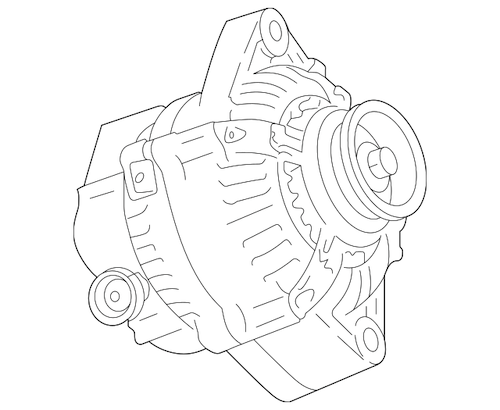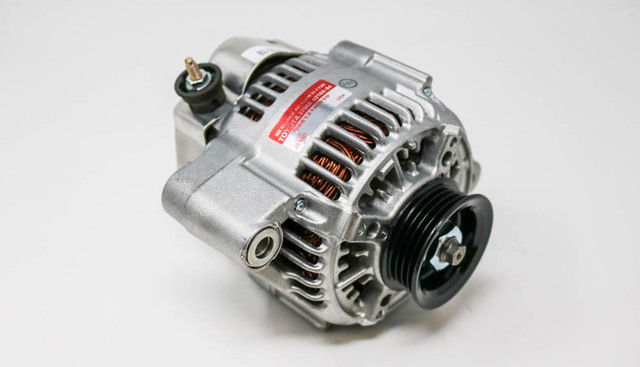You probably already know that some car parts are absolutely essential, and without them, your car just won’t function properly. One of these critical components is the alternator. This small yet vital part plays a crucial role in keeping your vehicle running smoothly by generating electricity to power everything from your headlights to your air conditioning system. At the same time, it ensures that your car’s battery stays charged, enabling continuous operation.
If you’re curious about learning more about alternators and their importance, you’ve come to the right place. This guide will walk you through everything you need to know about these indispensable automotive components.
What Exactly Is an Alternator?

Toyota alternator #27060-74750-84: for 1998-2000 RAV4s
Connected to your engine via a belt, the alternator is essentially a compact generator responsible for producing electricity for your car’s electrical systems. Whether it’s your dashboard lights, windshield wipers, or even your radio, the alternator keeps everything powered up. While the battery initially provides the initial power to start the engine, the alternator takes over once the car is running, ensuring that the battery remains fully charged and ready for action.
What Does an Alternator Look Like?

When you picture a Toyota alternator, think of something roughly the size of a grapefruit—about six pounds. Despite its small size, it’s packed with functionality. Although the design might vary depending on the Toyota model, all alternators share two key features:
- Plenty of ventilation holes to keep the alternator cool during operation.
- A rotor inside that spins to generate electricity for charging the battery.
Breaking it down further, an alternator consists of four main components:
- Stator: Converts mechanical energy into electrical energy.
- Rotor: Generates magnetic fields to create electricity.
- Diode: Transforms alternating current (AC) into direct current (DC).
- Voltage Regulator: Ensures the output voltage remains consistent.
How Does an Alternator Function?
The alternator begins supplying power to the battery as soon as you start your engine. Here’s a step-by-step breakdown of the process:
- Turn the ignition switch to start the engine.
- The engine begins running, causing the drive belt to spin the alternator pulley.
- As the rotor spins inside the alternator, it generates electricity using electromagnetic principles.
- This electricity flows through the stator to the diode, where it’s converted from AC to DC.
- The regulated DC current then travels to the car battery via the voltage regulator.
- Finally, the battery powers all the electrical components in the vehicle.
Is an Alternator Prone to Failure?

An alternator in action. Source: Phasmatisnox via Creative Commons
Like any other component in your car, alternators aren’t built to last forever. On average, they tend to last around 100,000 miles before needing replacement. Over time, various parts within the alternator can wear out, leading to potential failure. Common culprits include:
- Worn-out alternator pulleys.
- Faulty diodes.
- Defective voltage regulators.
- Damaged stators or coils.
- Loose or worn bushings and bearings.
In some cases, an alternator might fail prematurely due to improper installation or mishandling. For instance:
- A broken alternator pulley caused by incorrect tensioning.
- Poorly refurbished units that weren’t restored properly.
- New alternators damaged during shipping or handling, which can disrupt internal connections or bearing alignment.
How Much Does a New Alternator Cost?
When purchasing a brand-new OEM alternator for your Toyota, expect to pay anywhere from $150 to $900, depending on the specific model. However, if you opt for a remanufactured alternator, you’ll likely save significantly compared to buying new.
To maximize savings, consider ordering directly from authorized online retailers rather than local dealerships. Dealerships often charge steep markups on parts, whereas online sellers operate with lower operational costs. In fact, many reputable suppliers offer wholesale pricing, making them an excellent option for budget-conscious buyers. Additionally, refurbished alternators provide another cost-effective alternative without sacrificing quality.
Ready to find the perfect alternator for your Toyota? Browse our extensive catalog of genuine OEM parts today!
Written by Jason Lancaster
Laser Cutting Machine,Cnc Optical Fiber Laser Cutter,Hardware Sheet Metal Laser Cutting Machine,Jewelry Fiber Laser Cutting Machine
Herolaser , https://www.herolasermachine.com
